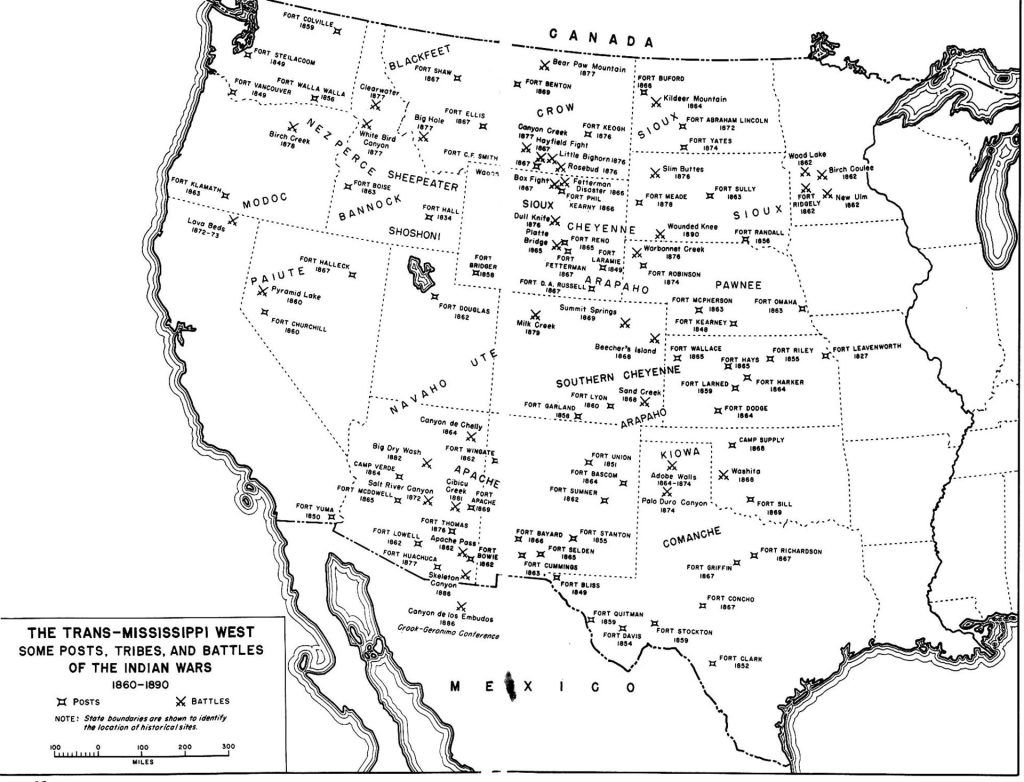Introduction
Between 1860 and 1890, indigenous peoples living west of the Mississippi River faced relentless pressure from the United States government to surrender their lands and lifeways. The growing nation wanted land and indigenous people stood in its way.
As it had done previously and to the east, the US government first used treaties to acquire land in the trans-Mississippi West. That process was always problematic, and it became so disastrous that Congress outlawed it in 1871. Instead of negotiating with indigenous nations, Congress would now legislate for them. When treaty-mandated reservations became poverty stricken and expensive for the government to administer, it began to dismantle communal ownership and assign parcels to individual families. Like previous forced assimilation attempts, this too failed and led to the loss of even more indigenous lands. To make matters more difficult, the period also saw the proliferation of Indian boarding schools. First run by religious organizations but then increasingly by the US government, these schools removed indigenous kids from their homes – through coercion and force at times – and placed them in residential schools where administrators required students to cut their hair, wear European-style clothing, and speak only English while learning to read, write, and work. All the while, wagon trains, steam locomotives, and horse-mounted soldiers increasingly crisscrossed indigenous homelands.
In the face of such multi-faceted attacks on culture, leaders had a diminishing set of options to protect their land, people, and culture. Often with no good choices left, Indigenous nations fought the US government in last-ditch efforts to defend their homes. These battles, sometimes still called the Indian Wars, are an iconic, if devastating part of the American history narrative. This part of the larger story begins with a conflict in 1862 between factions of Dakota and Euro-American settlers supported by US troops in Minnesota and concludes with the massacre of Lakota people at Wounded Knee in 1890. In-between these two events, dozens of military confrontations occurred – each with its own set of causes, events, and consequences, but ones that have striking similarities with other conflicts of similar time and place. (see map below). It is a heart-breaking story and one that at the same time brought us such American heroes as Red Cloud, Sitting Bull, Geronimo, and Chief Joseph.
The Trans-Mississippi West: Post and Battles, 1860-1890
This open educational resource was developed for college classroom and is comprised of three stories of conflict from this period: The U.S. Dakota War of 1862, The Nez Perce War of 1877, and the Massacre at Wounded Knee in 1890. This small but representative sample provides insight into indigenous-US relations and illustrates themes consistent throughout the period: lack of real choice, miscommunication that led to devastation, admirable diplomatic and military prowess, and eventual indigenous defeat.
In addition to short narratives describing the conflicts, each chapter provides opportunities for students to investigate the historical record surrounding the events. In “Minnesota’s Civil War: The U.S. Dakota War of 1862,” students are invited to consider Little Crow’s famous speech on the eve of battle. The little-discussed details of how his speech passed into the historical record suggest that historians may want to quote it with caution.
In “I Fight No More Forever: The Nez Perce War of 1877,” students read and analyze a less-well-known speech from Chief Joseph that serves to highlight the inherent problems and frustrations indigenous people felt when dealing with the U.S. government.
In “The American Tragedy at Wounded Knee Creek – 1890,” students are asked to analyze first-person accounts of how the massacre began. The accounts come from a variety of perspectives, and as you might imagine, they offer strikingly different and contradictory versions of the “facts.”


